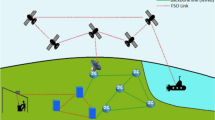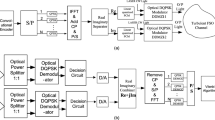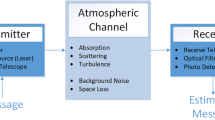Abstract
In free-space optical (FSO) communication, Distribution models such as lognormal, gamma-gamma, and k-distribution describe weak, moderate, and strong turbulence, respectively. Whereas Málaga \(\left( {\mathcal{M}} \right)\) distribution is a powerful statistical model repeatedly mentioned in the literature due to its generality, Málaga \(\left( {\mathcal{M}} \right)\) describes the three turbulence conditions while considering the pointing errors, represented by the jitter boresight displacement, of the communication beam. Exact and closed-form expressions for symbol error rate and outage probability are presented in this paper—furthermore, cases from these expressions are presented for various turbulence conditions. The proposed expressions describe the symbol error rate and outage probability performance of the FSO communication system with M-ary amplitude shift keying modulation over Málaga \(\left( {\mathcal{M}} \right)\) atmospheric turbulence environments.










Similar content being viewed by others
References
Al-Nahhal, M., Ismail, T.: Enhancing spectral efficiency of FSO system using adaptive SIM/M-PSK and SIMO in the presence of atmospheric turbulence and pointing errors. Int. J. Commun. Syst. 32(9), 1–13 (2019)
Alshaer, N., Ismail, T., Nasr, M.E.: Generic evaluation of FSO system over M ̀alaga turbulence channel with MPPM and nonzero-boresight pointing errors. In: IET Communications, September 2020
Ansari, I.S., Yilmaz, F., Alouini, M.-S.: Performance analysis of free-space optical links over Málaga (M) turbulence channels with pointing errors. IEEE Trans. Wireless Commun. 15(1), 91–102 (2016)
Balsells, J.M.G., Navas, A.J., Paris, J.F., Vazquez, M.C., Notario, A.P.: General analytical expressions for the bit error rate of atmospheric optical communication systems: erratum. Opt. Lett. 39(20), 5896 (2014)
Bhatnagar, M., Ghassemlooy, Z.: Performance analysis of Gamma-Gamma fading FSO MIMO links with pointing errors. IEEE/OSA J. Lightwave Technol. 34(9), 2158–2169 (2016)
Bloom, S., Korevaar, E., Schuster, J., Willebrand, H.: Understanding the performance of free-space optics. Opt. Netw. 2, 178–200 (2003)
Borah, D.K., Voelz, D., Basu, S.: Maximum-likelihood estimation of a laser system pointing parameters by use of return photon counts. Appl. Opt. 45, 2504–2509 (2006)
Gappmair, W.: Further results on the capacity of free-space optical channels in turbulent atmosphere. IET Commun. 5(9), 1262–1267 (2011)
Gappmair, W., Hranilovic, S., Leitgeb, E.: OOK performance for terrestrial FSO links in turbulent atmosphere with pointing errors modeled by Hoyt distributions. IEEE Commun. Lett. 15, 875–877 (2011)
Gappmair, W., Hranilovic, S., Leitgeb, E.: Performance of PPM on terrestrial FSO links with turbulence and pointing errors. IEEE Commun. Lett. 14, 468–470 (2010)
Gradshteyn, I.S., Ryzhik, I.M.: Table of Integrals, Series, and Products, 7th edn. Academic Press, New York (2000)
Hamza, A.S., Deogun, J.S., Alexander, D.R.: Classification framework for free space optical communication links and systems. IEEE Commun. Surv. Tutor. 21(2), 1346–1382 (2018)
Hogan, M.: Data demands drive free-space optics. Photon. Spectra 47(2), 38–42 (2013)
Ismail, T., Leitgeb, E., Plank, T.: Free space optic and mmWave communications: technologies, challenges and applications. IEICE Trans. Commun. 99(6), 1243–1254 (2016)
Ismail, T., Leitgeb, E., Ghassemlooy, Z., Al-Nahal, M.: Performance improvement of FSO system using multi-pulse PPM and SIMO under atmospheric turbulence conditions and with pointing errors. In: IET Networks, July 2018
Liu, X.: Free-space optics optimization models for building sway and atmospheric interference using variable wavelength. IEEE Trans. Commun. 57, 492–498 (2009)
Navas, A.J., Balsells, J.M.G., Paris, J.F., Notario A.P.: A unifying statistical model for atmospheric optical scintillation. In: Numerical Simulations of Physical and Engineering Processes, J. Awrejcewicz, Ed. Intech, 2011, Chap. 8
Navas, A.J., Balsells, J.M.G., Paris, J.F., Notario, A.P.: A unifying statistical model for atmospheric optical scintillation. In: Numerical Simulations of Physical and Engineering Processes, J. Awrejcewicz, Ed. Intech, 2011, Chap. 8
Navas, A.J., Balsells, J.M.G., Paris, J.F., Vazquez, M.C., Notario, A.P.: Impact of pointing errors on the performance of generalized atmospheric optical channels. Opt. Express 20(11), 550–562 (2012)
Navas, A.J., Balsells, J.M.G., Paris, J.F., Vazquez, M.C., Notario, A.P.: General analytical expressions for the bit error rate of atmospheric optical communication systems. Opt. Lett. 36(20), 4095–4097 (2011)
Navidpour, S.M., Uysal, M., Kavehrad, M.: BER performance of freespace optical transmission with spatial diversity. IEEE Trans. Wireless Commun. 6(8), 2813–2819 (2007)
Proakis, J.: Digital Communications, 4th edn. McGrawHill, New York (2001)
Samimi, H., Uysal, M.: Performance of coherent differential phase shift keying free-space optical communication systems in M-distributed turbulence. IEEE OSA J. Opt. Commun. Netw. 5(7), 704–710 (2013)
Sandalidis, H., Tsiftsis, T., Karagiannidis, G., Uysal, M.: BER performance of FSO links over strong atmospheric turbulence channels with pointing errors. IEEE Commun. Lett. 12, 44–46 (2008)
Wang, Z., Giannakis, G.B.: A simple and general parameterization quantifying performance in fading channels. IEEE Trans. Commun. 51, 1389–1398 (2003)
Wolfram, The wolfram functions site: http://functions.wolfram.com/, (2020)
Yang, F., Cheng, J., Tsiftsis, T.A.: Free-space optical communication with nonzero boresight pointing errors. IEEE Trans. Commun. 62(2), 713–725 (2014)
Yasser, M., Ismail T., Ghuniem A.: M-ary ASK Modulation in FSO system with SIMO over log-normal atmospheric turbulence with pointing errors. In: 11th International Symposium on Communication Systems, Networks and Digital Signal Processing (CSNDSP), Budapest, July 2018
Author information
Authors and Affiliations
Corresponding author
Additional information
Publisher's Note
Springer Nature remains neutral with regard to jurisdictional claims in published maps and institutional affiliations.
Appendices
Appendix A: Málaga composite PDF
(1) Composite PDF Approximation: We substitute (2) and (3) into (5) and write the composite PDF of the Málaga fading with nonzero boresight pointing error as
Applying the change of variables rule \(x = \sqrt {\frac{{ - w_{{z_{eq} }}^{2} }}{2}lnln \left( {\frac{h}{{h_{a} A_{0} h_{l} }}} \right) }\), Eq. (A.1) can be expressed as
where \(W_{\left( h \right)} = hK_{\alpha - k} \left( {2\sqrt {\frac{\alpha \beta h}{{g\beta + \Omega^{\prime}}}exp\left( {\frac{{2x^{2} }}{{w_{{z_{eq} }}^{2} }}} \right)} } \right).\)
Using series expansion of modified Bessel function of the second kind (Wolfram 2020)
where it requires \(v \notin Z\) and \(\left| x \right| < \infty\), we can express \(W_{\left( h \right)}\) as
Substituting (A.4) into (A.2), and after some manipulation, we have
In the following derivation, using integral identity (Gradshteyn and Ryzhik 2000) we get
where, \(M_{ - u, v} \left( . \right)\) is the Whittaker function and with using another the identity (Wolfram 2020)
We represent (A.5) as in (6). In our derivation, the (A.2) integral identity requires that \(\left( {\alpha - \beta } \right) \notin Z\), and the integral identity (A.5) requires that the summation index \(j\) in (A.4) must be equal to or lower than \(J = \left\lfloor {\gamma 2 - \alpha } \right\rfloor\), where \(\left\lfloor x \right\rfloor\) denotes the maximum integer not greater than \(x\).
(2) PDF Near the Origin: To get the power series expansion of the Málaga composite PDF near the origin, \(W_{\left( h \right)}\) could be expressed as
From (A.8) and (A.2), we can derive the PDF near the origin as
Appendix B: Lognormal composite PDF
For weak turbulence conditions, we use the lognormal turbulence model to characterize the atmospheric fading ha whose PDF is given by Yang et al. (2014)
where \(\sigma_{X}^{2}\) is the log-amplitude variance given by \(\sigma_{X}^{2} = \frac{{\sigma_{R}^{2} }}{4} = 0.31k^{7/6} C_{n}^{2} z^{11/6 }\), where \(\sigma_{R}^{2}\) is the Rytov variance for a plane wave, \(C_{n}^{2}\) is the index of refraction structure parameter of atmosphere, and \(k = 2\pi /\lambda\) is the optical wave number with \(\lambda\) being the wavelength. The parameters of the lognormal fading model can be measured directly for FSO systems.
After some mathematical derivation, we obtain a finite series approximation of the composite PDF as (Yang et al. 2014)
where \(u_{a} = \frac{{s^{2} }}{{\sigma_{s}^{2} }} + 2\sigma_{X}^{2} \gamma^{2} + 2\sigma_{X}^{2} \gamma^{4}\), \(u_{b} = \frac{{6s^{2} }}{{\sigma_{s}^{2} }} + 2\sigma_{X}^{2} + 4\sigma_{X}^{2} \gamma^{2}\), \(u_{c} = \sqrt {8\left( {\frac{{4s^{2} \sigma_{s}^{2} }}{{w_{{z_{eq} }}^{4} }} + \sigma_{X}^{2} } \right)} .\)
We derive the average SER of lognormal fading with nonzero boresight pointing error by substituting (B.2) into (5). The BER expression can be written as
Using a change of variable rule, (B.3) can be expressed as
(B.4) can be approximated as
where \(B\) is an an auxiliary parameter.
Using a series expansion of the complementary error function (Wolfram 2020), Eq. (06.27.06.0002.01)]
And, an integral identity (Wolfram 2020), Eq. (06.27.21.0011.01)]
An infinite series expression of the SER can be written as
where
Appendix C: Gamma-gamma composite PDF
For medium to strong turbulence conditions, we use the Gamma-Gamma turbulence model to characterize the atmospheric fading ha whose PDF is given by (Yang et al. 2014)
Γ(·) is the Gamma function, and \(K_{{\alpha_{GG} - \beta_{GG} }} \left( . \right)\) is the modified Bessel function of the second kind of order \(\alpha_{GG} - \beta_{GG}\).The parameters \(\alpha_{GG}\) and \(\beta_{GG}\) are related to the small large scale eddies respectively. We obtain the composite PDF as (Yang et al. 2014)
where
By using (7) and (C.2) into (8)
The average SER is given by
Appendix D: K-distribution composite PDF
For medium to strong turbulence conditions, we use the K-distribution turbulence model to characterize the atmospheric fading ha whose PDF is given by
where \(h_{a}\) denotes the optical signal intensity \(\alpha_{k}\) is the channel parameter related to the effective number of descrete scatterers, in this analysis \(1 < \alpha_{k} < 2.\)
We substitute (2) and (D.1) into (5) and write the composite PDF of the K-distribution fading with nonzero boresight pointing error as
After mathematical derivation, we obtain a finite series approximation of the composite PDF as
where
By using (7) and (D.3) into (8), it becomes
The average SER is given by
Rights and permissions
About this article
Cite this article
Yasser, M., Ghuniem, A., Hassan, K.M. et al. Impact of nonzero boresight and jitter pointing errors on the performance of M-ary ASK/FSO system over Málaga \(\left( {\mathcal{M}} \right)\) atmospheric turbulence. Opt Quant Electron 53, 46 (2021). https://doi.org/10.1007/s11082-020-02715-9
Received:
Accepted:
Published:
DOI: https://doi.org/10.1007/s11082-020-02715-9




